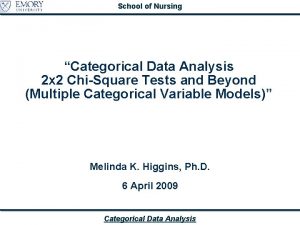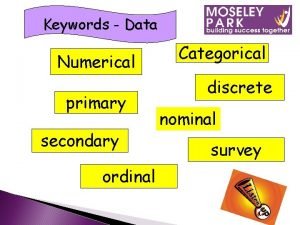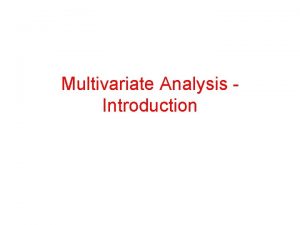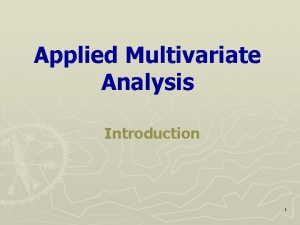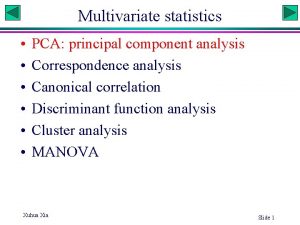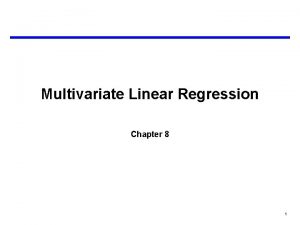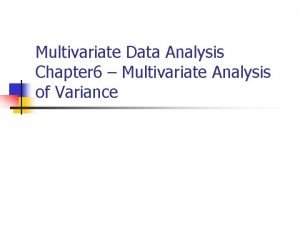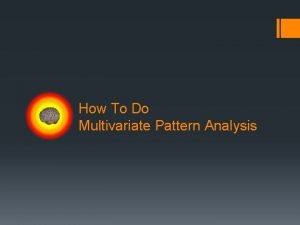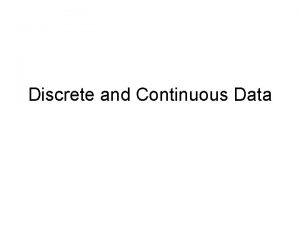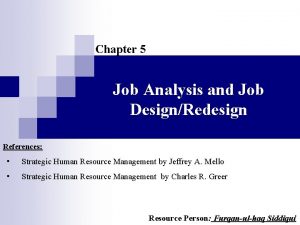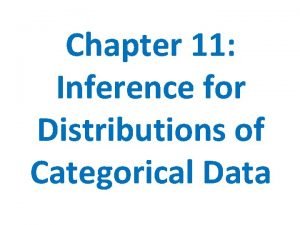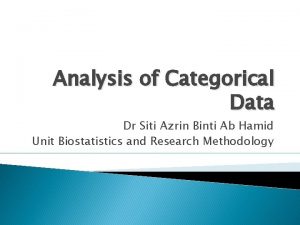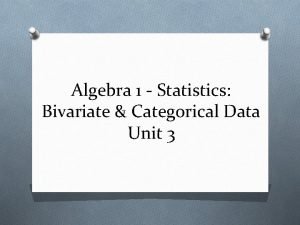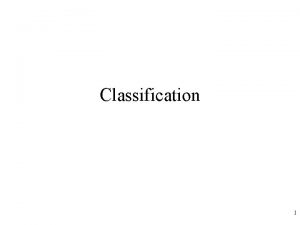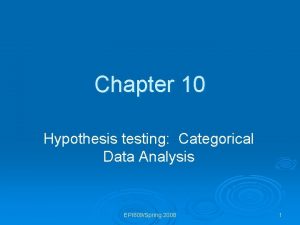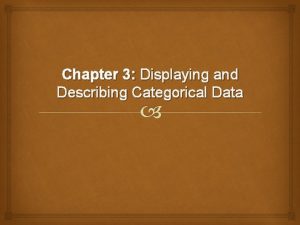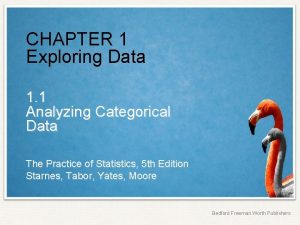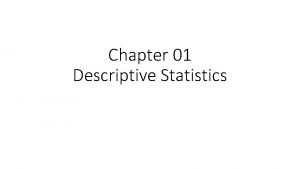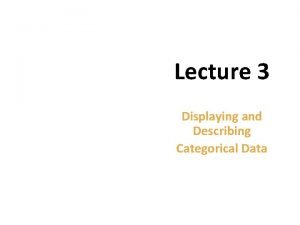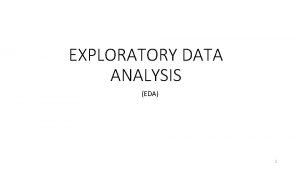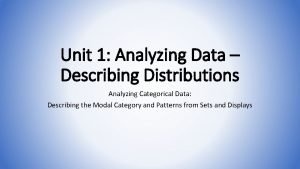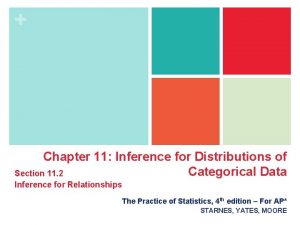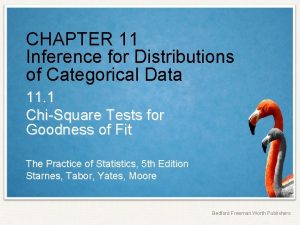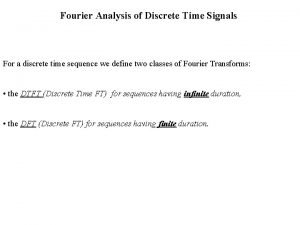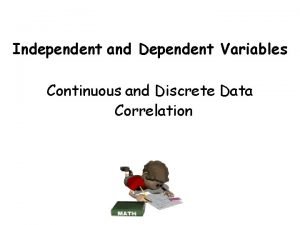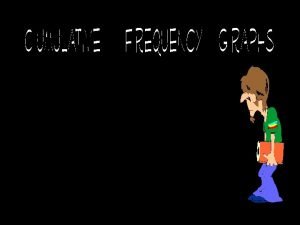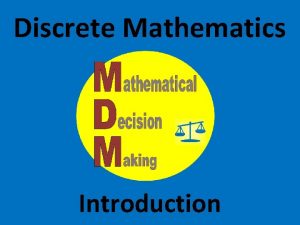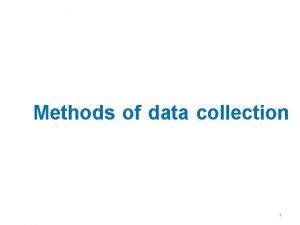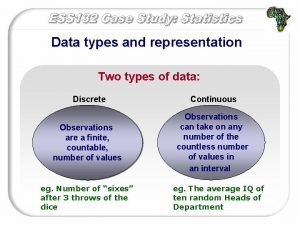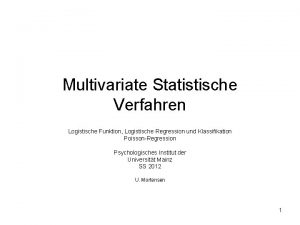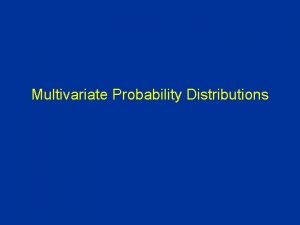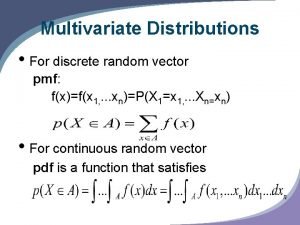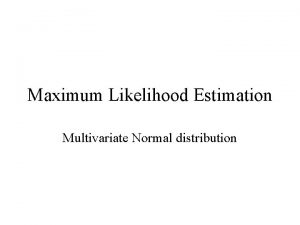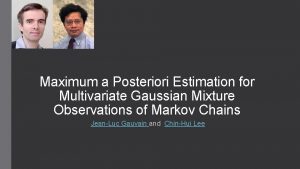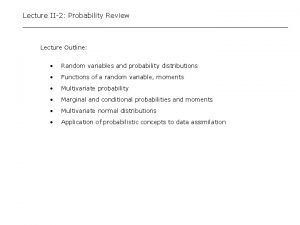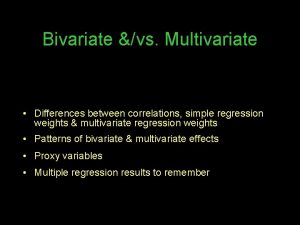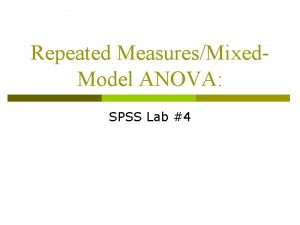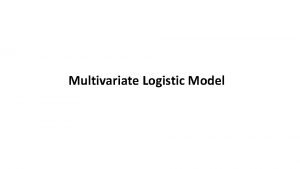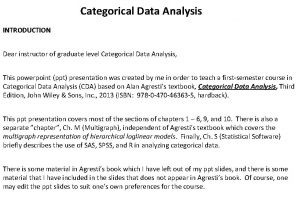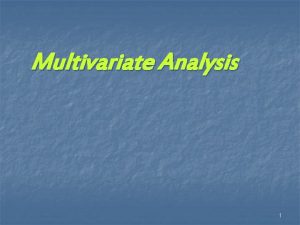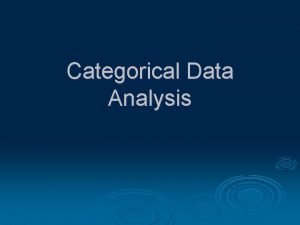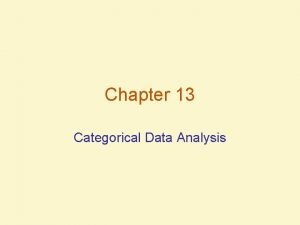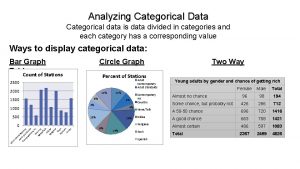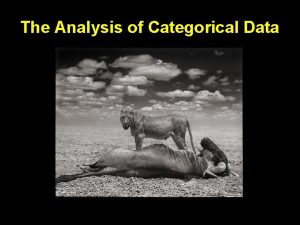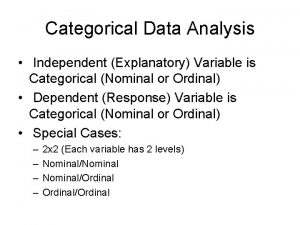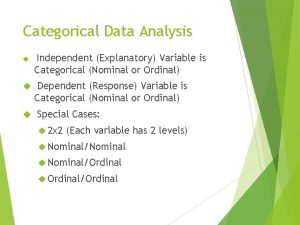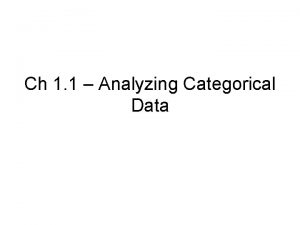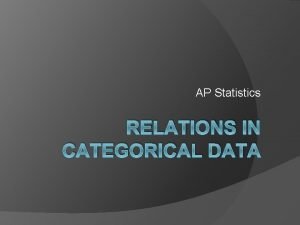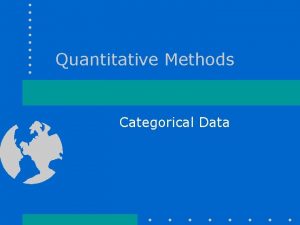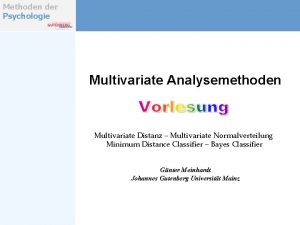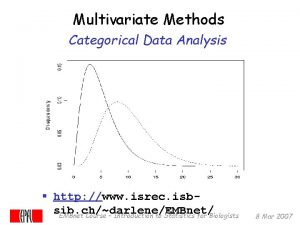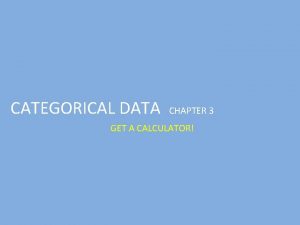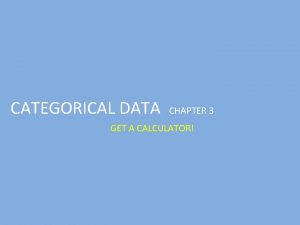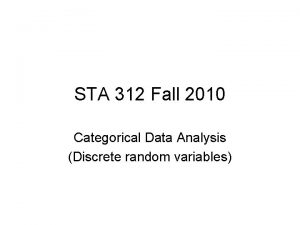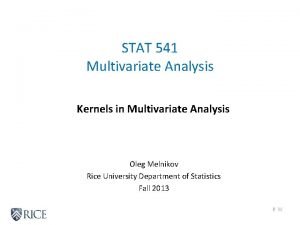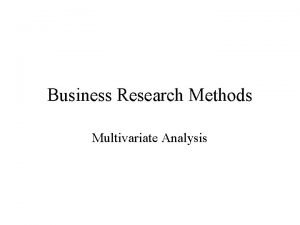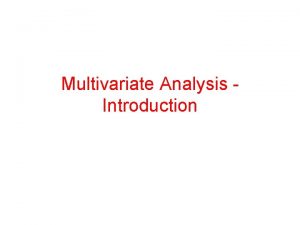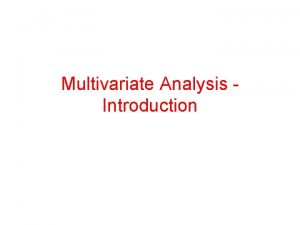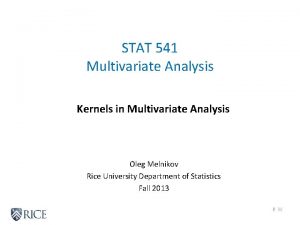Discrete Multivariate Analysis of Multivariate Categorical Data References







![Hierarchical Log-linear models for 3 way table Model [1][2][3] [1][23] [2][13] [3][12][13] [12][23] [13][23] Hierarchical Log-linear models for 3 way table Model [1][2][3] [1][23] [2][13] [3][12][13] [12][23] [13][23]](https://slidetodoc.com/presentation_image_h2/973655823abaee858350ba72b1e90405/image-8.jpg)















![Model 1: [BH][CH] Log-linear parameters Heart disease -Blood Pressure Interaction Model 1: [BH][CH] Log-linear parameters Heart disease -Blood Pressure Interaction](https://slidetodoc.com/presentation_image_h2/973655823abaee858350ba72b1e90405/image-24.jpg)



![Model 2: [BC][BH][CH] Log-linear parameters Blood pressure-Cholesterol interaction: Model 2: [BC][BH][CH] Log-linear parameters Blood pressure-Cholesterol interaction:](https://slidetodoc.com/presentation_image_h2/973655823abaee858350ba72b1e90405/image-28.jpg)











![Fitting various log-linear models Simplest model that fits is: [Apt, Ed][Occ, Ed] This model Fitting various log-linear models Simplest model that fits is: [Apt, Ed][Occ, Ed] This model](https://slidetodoc.com/presentation_image_h2/973655823abaee858350ba72b1e90405/image-40.jpg)





- Slides: 45

Discrete Multivariate Analysis of Multivariate Categorical Data

References 1. Fienberg, S. (1980), Analysis of Cross-Classified Data , MIT Press, Cambridge, Mass. 2. Fingelton, B. (1984), Models for Category Counts , Cambridge University Press. 3. Alan Agresti (1990) Categorical Data Analysis, Wiley, New York.

Log Linear Model

Two-way table where Note: X and Y are independent if In this case the log-linear model becomes

Three-way Frequency Tables

Log-Linear model for three-way tables Let mijk denote the expected frequency in cell (i, j, k) of the table then in general where

Hierarchical Log-linear models for categorical Data For three way tables The hierarchical principle: If an interaction is in the model, also keep lower order interactions and main effects associated with that interaction
![Hierarchical Loglinear models for 3 way table Model 123 123 213 31213 1223 1323 Hierarchical Log-linear models for 3 way table Model [1][2][3] [1][23] [2][13] [3][12][13] [12][23] [13][23]](https://slidetodoc.com/presentation_image_h2/973655823abaee858350ba72b1e90405/image-8.jpg)
Hierarchical Log-linear models for 3 way table Model [1][2][3] [1][23] [2][13] [3][12][13] [12][23] [13][23] [12][13] [23] [123] Description Mutual independence between all three variables. Independence of Variable 1 with variables 2 and 3. Independence of Variable 2 with variables 1 and 3. Independence of Variable 3 with variables 1 and 2. Conditional independence between variables 2 and 3 given variable 1. Conditional independence between variables 1 and 3 given variable 2. Conditional independence between variables 1 and 2 given variable 3. Pairwise relations among all three variables, with each two variable interaction unaffected by the value of the third variable.

Maximum Likelihood Estimation Log-Linear Model

For any Model it is possible to determine the maximum Likelihood Estimators of the parameters Example Two-way table – independence – multinomial model or

Log-likelihood where With the model of independence

and with also

Let Now

Since

Now or

Hence and Similarly Finally

Hence Now and

Hence Note or

Comments • Maximum Likelihood estimates can be computed for any hierarchical log linear model (i. e. more than 2 variables) • In certain situations the equations need to be solved numerically • For the saturated model (all interactions and main effects)

Goodness of Fit Statistics These statistics can be used to check if a log-linear model will fit the observed frequency table

Goodness of Fit Statistics The Chi-squared statistic The Likelihood Ratio statistic: d. f. = # cells - # parameters fitted We reject the model if c 2 or G 2 is greater than

Example: Variables 1. Systolic Blood Pressure (B) Serum Cholesterol (C) Coronary Heart Disease (H)

Goodness of fit testing of Models MODEL ----B, C, H. B, CH. C, BH. H, BC. BC, BH. BH, CH. CH, BC. BC, BH, CH. DF -24 21 21 15 12 18 12 9 LIKELIHOODRATIO CHISQ -----83. 15 51. 23 59. 59 58. 73 35. 16 27. 67 26. 80 8. 08 PROB. ------0. 0000 0. 0002 0. 0000 0. 0004 0. 0673 0. 0082 0. 5265 PEARSON CHISQ ------102. 00 56. 89 60. 43 64. 78 33. 76 26. 58 33. 18 6. 56 PROB. ------0. 0000 0. 0007 0. 0872 0. 0009 0. 6824 Possible Models: 1. [BH][CH] – B and C independent given H. 2. [BC][BH][CH] – all two factor interaction model n. s.
![Model 1 BHCH Loglinear parameters Heart disease Blood Pressure Interaction Model 1: [BH][CH] Log-linear parameters Heart disease -Blood Pressure Interaction](https://slidetodoc.com/presentation_image_h2/973655823abaee858350ba72b1e90405/image-24.jpg)
Model 1: [BH][CH] Log-linear parameters Heart disease -Blood Pressure Interaction

Multiplicative effect Log-Linear Model

Heart Disease - Cholesterol Interaction

Multiplicative effect
![Model 2 BCBHCH Loglinear parameters Blood pressureCholesterol interaction Model 2: [BC][BH][CH] Log-linear parameters Blood pressure-Cholesterol interaction:](https://slidetodoc.com/presentation_image_h2/973655823abaee858350ba72b1e90405/image-28.jpg)
Model 2: [BC][BH][CH] Log-linear parameters Blood pressure-Cholesterol interaction:

Multiplicative effect

Heart disease -Blood Pressure Interaction

Multiplicative effect

Heart Disease - Cholesterol Interaction

Multiplicative effect

Another Example In this study it was determined for N = 4353 males 1. Occupation category 2. Educational Level 3. Academic Aptidude

1. Occupation categories a. b. c. d. Self-employed Business TeacherEducation Self-employed Professional Salaried Employed 2. Education levels a. b. c. d. e. Low/Med High/Med High

3. Academic Aptitude a. b. c. d. Low/Med High



• It is common to handle a Multiway table by testing for independence in all two way tables. • This is similar to looking at all the bivariate correlations • In this example we learn that: 1. Education is related to Aptitude 2. Education is related to Occupational category 3. Education is related to Aptitude Can we do better than this?
![Fitting various loglinear models Simplest model that fits is Apt EdOcc Ed This model Fitting various log-linear models Simplest model that fits is: [Apt, Ed][Occ, Ed] This model](https://slidetodoc.com/presentation_image_h2/973655823abaee858350ba72b1e90405/image-40.jpg)
Fitting various log-linear models Simplest model that fits is: [Apt, Ed][Occ, Ed] This model implies conditional independence between Aptitude and Occupation given Education.

Log-linear Parameters Aptitude – Education Interaction

Aptitude – Education Interaction (Multiplicative)

Occupation – Education Interaction

Occupation – Education Interaction (Multiplicative)

Next topic: Conditional test Statistics
 Categorical logic in nursing
Categorical logic in nursing Secondry keywords
Secondry keywords Multivariate analysis
Multivariate analysis Multi variance
Multi variance Nature of multivariate analysis
Nature of multivariate analysis Multivariate analysis of variance and covariance
Multivariate analysis of variance and covariance Multivariate analysis
Multivariate analysis Multivariate statistical analysis
Multivariate statistical analysis Multivariate analysis
Multivariate analysis Multivariate analysis
Multivariate analysis Multivariate pattern analysis
Multivariate pattern analysis Discrete data
Discrete data Dejobbing
Dejobbing Chapter 11 inference for distributions of categorical data
Chapter 11 inference for distributions of categorical data What statistical test for categorical data
What statistical test for categorical data Bivariate cpm
Bivariate cpm Categorical data classification
Categorical data classification H0no
H0no Categorical data displays
Categorical data displays Analyzing categorical data
Analyzing categorical data Categorical data examples
Categorical data examples Conditional relative frequency
Conditional relative frequency Categorical variable meaning
Categorical variable meaning Eda 1
Eda 1 Analyzing categorical data
Analyzing categorical data Chapter 11 inference for distributions of categorical data
Chapter 11 inference for distributions of categorical data Chapter 11 inference for distributions of categorical data
Chapter 11 inference for distributions of categorical data Fourier analysis of discrete time signals
Fourier analysis of discrete time signals Independent variable is what axis
Independent variable is what axis Discrete data
Discrete data Cumulative frequency graph for discrete data
Cumulative frequency graph for discrete data Discrete data
Discrete data Discrete or continuous data
Discrete or continuous data Two type of data
Two type of data Numerical integration of discrete data
Numerical integration of discrete data Logistisches wachstum ableitung
Logistisches wachstum ableitung Multivariate binomial distribution
Multivariate binomial distribution Multivariate pdf
Multivariate pdf Mahalanobis distance spss
Mahalanobis distance spss Q1qp
Q1qp Maximum a posteriori estimation for multivariate gaussian
Maximum a posteriori estimation for multivariate gaussian Multivariate pdf
Multivariate pdf Multivariate vs bivariate
Multivariate vs bivariate Mixed design anova spss
Mixed design anova spss Normal equation logistic regression
Normal equation logistic regression Multivariate methods in machine learning
Multivariate methods in machine learning
